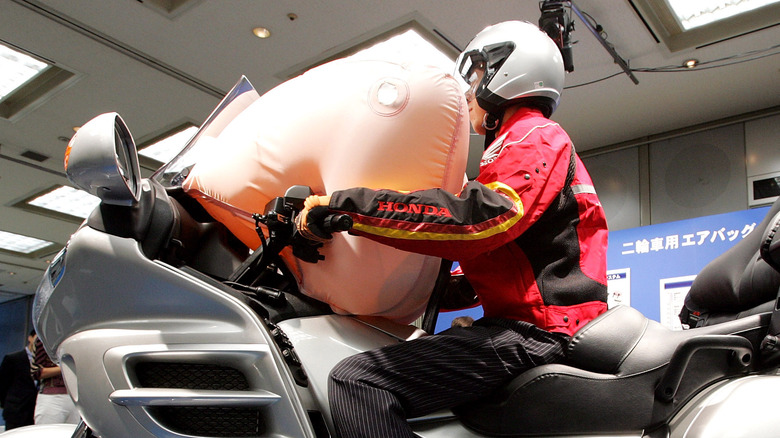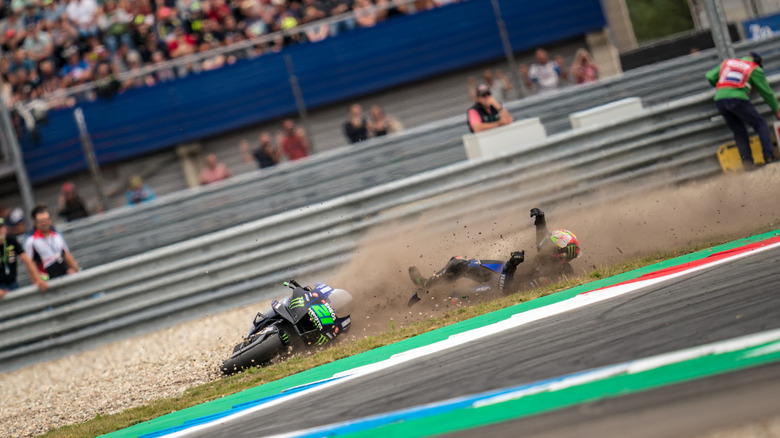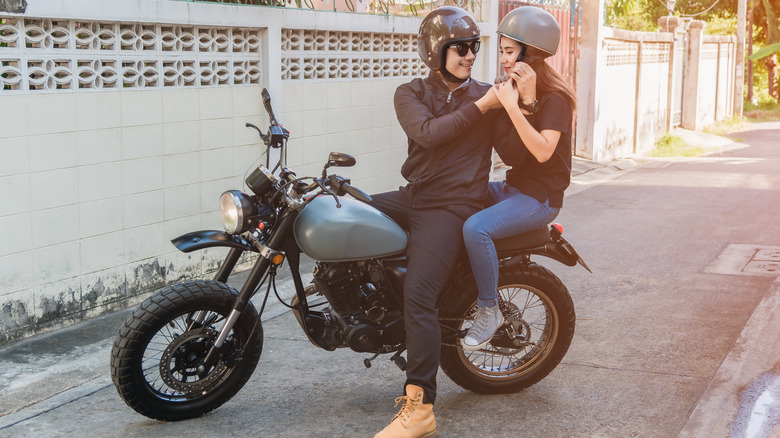The Real Reason Why Nobody Uses Motorcycle Airbags
Motorcycling can be a very enjoyable way to spend a casual afternoon in the middle of a summer Sunday or an inexpensive way to commute to and from the office on weekdays. Whatever your reason for riding a motorcycle, it certainly is an enjoyable way to get from A to B particularly as motorcycles deliver a lot more performance on a bang-for-your-buck basis than the average car. However, there is a significant downside to motorcycle riding. Motorcycle riders don't have the protective cage that is offered by cars making them more susceptible to serious injury in a crash.
The statistics don't lie. Motorcycle riders are substantially overrepresented in fatal crashes. In 2019, motorcycle riders were a massive 29 times more likely to die per mile traveled than someone driving a car, according to the NHTSA (PDF). There are, however, ways that riders can reduce their chance of dying in a motorcycle crash. For example, unhelmeted riders are three times more likely to suffer a traumatic brain injury in a crash than a rider wearing a helmet, NHTSA data shows (PDF). Buying a motorcycle equipped with an antilock braking system (ABS) can reduce the likelihood that a motorcycle rider would become involved in a serious crash by 22 percent when compared to the same models not equipped with ABS (via Revzilla).
Here comes the airbag
Honda announced a major step forward for motorcycle safety back in 2005 when it fitted its Gold Wing with an airbag. The system works much like a car airbag by deploying in the event of a frontal collision absorbing some of the forward energy of the rider potentially reducing the seriousness of an impact. The major drawback of the system is that riders can still be hit from either side by a car or from behind leaving numerous ways riders can still come off and be seriously or fatally injured. Honda's system works reasonably well for its Gold Wing range but hasn't yet made the transition to other types of motorcycles.
Motorcyclists can mitigate injury from a crash by wearing a helmet in combination with other personal protective equipment (PPE). Research undertaken in Australia found motorcyclists who wore PPE suffered less serious injuries and post-crash pain and spent less time in a hospital following a crash.
PPE has been an area of intense interest for equipment makers looking to better protect riders since the dawn of the vehicle. Leather boots, chaps, jackets, and gloves have been standard PPE for riders for decades. Modern PPE also includes wearing high-visibility clothing so that riders are easily visible to other motorists on the road. One of the most innovative pieces of PPE in recent years is the integration of an airbag system into a rider's clothing.
Airbag suits are mandatory in MotoGP
Airbags built into the racing suits of MotoGP riders were made mandatory in 2018 (via MotoGP.com). In explaining the change the sports governing body, the Fédération Internationale de Motocyclisme (FIM), argued the change would boost safety by specifically protecting the shoulders and collarbones of riders. Back protection currently remains optional, but a back protection airbag system, if used, should protect the entire spine.
Similar, but somewhat less sophisticated systems are also available to regular road riders, as shown in the video above. Some use a tether system attached to the rider that is triggered when the rider falls off the bike, while others use electronic monitoring suits to detect when a rider is in a crash before activating.
Not satisfied with protecting the upper torso, some manufacturers have started implementing airbag technology in motorcycle pants as well. The most common injuries to motorcycle riders (other than head injuries) affect lower limbs, according to one study – which should mean that airbag technology and basic leg protection with PPE should be as much a priority for riders as any other part of their body.
The U.S. Army strongly recommends (PDF) the use of high-quality PPE when riding motorcycles for improved crash outcomes. Yet, despite this and similar guidance from road safety authorities, wearing PPE with airbags or even without isn't favored by many motorcyclists. So what gives?
Arrive alive or go for the vibe?
Vanity, it seems. Motorcyclists like to look cool when they ride and for many, that means choosing not to wear high-visibility clothing or other forms of PPE including gloves, helmets, jackets, pants, and boots, let alone airbags-equipped PPE. Motorcyclists also complain about PPE getting too hot in summer and being uncomfortable, as this Reddit thread on the subject demonstrates. The price of specialized PPE can also be a deterrent, especially for motorcyclists who ride because filling a full-sized vehicle with gasoline isn't cheap.
The NHTSA undertook research into motorcyclists' attitudes towards PPE (PDF) and has a few suggestions to encourage widespread use. This includes making motorcycle PPE more appealing while incorporating more high-visibility design elements, providing financial incentives like insurance discounts, and bolstering educational messaging.
Airbag-equipped motorcycles are still relatively rare and expensive. Airbag-equipped wearable gear was, at first, sort of expensive — but as time goes on, the price and styling of airbag-equipped motorcycle gear inches closer to a place where the average motorcyclist can get onboard. While it's still fairly common to see a motorcyclist riding without proper protective gear on the highway today, the age of the dangerously unsafe and unprotected motorcyclist might not last forever.


